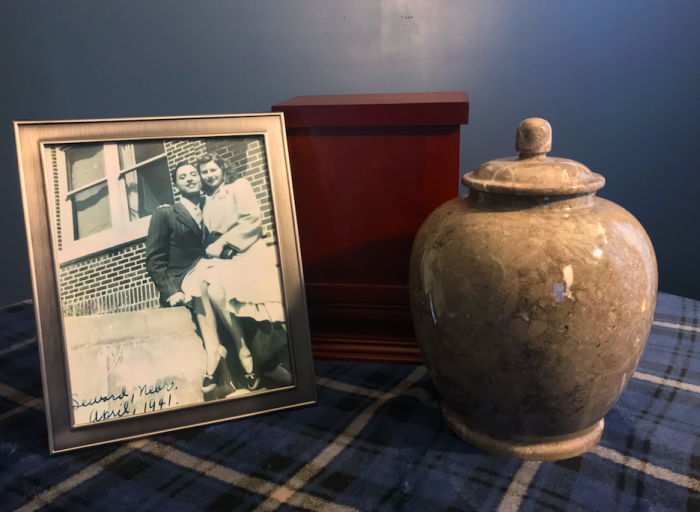It’s a simple question: how do I want to dispose of my body when I die?
A simple question with no easy answer.
The urns with my parents’ ashes have been in my home for the last 18 years. Putting this on paper turns my stomach. With guilt.
Having the power of attorney for my father’s health care when he died put the responsibility on me to take the lead. He had made the decision to be cremated but didn’t go any farther to say what he wanted to have done with his ashes. Neither had my mother.
My siblings and I couldn’t agree. One sibling shuddered at the thought of the ashes being kept in a niche wall, my other siblings had no preference, and being the eternal peacemaker in our family, I deferred. My siblings did agree on one thing, “Why don’t you keep them for now?”
“Now” became 18 years.
The urns moved with me from one home to the next, as I continued to avoid thinking about them or dealing with them in any meaningful way. Eighteen years of avoidance. The impermanence of my parents’ lives was permanently in my purview, although I kept avoiding it.
Was I really that uncomfortable with impermanence? Or was it my discomfort in thinking about dead bodies? Are those one in the same?
My parents had put enough forethought into preparations for their deaths to decide upon cremation for their bodies. I know from the many conversations with my father that it was simply a financial decision for him, as cremation was much less expensive than burial in a casket.
Feeling utterly guilty for not having addressed the issue sooner, I couldn’t stand it any longer.
I told them I was no longer comfortable housing the urns with the ashes. We came to a unanimous decision to scatter the ashes. Finally, a solution. Not so quick. One sister informed me that scattering the ashes over a river or ocean isn’t environmentally safe. She also noted that it’s illegal to scatter ashes over land you don’t own.
One question leads to the next. Is there a reverent and green way to dispose of the body?
I did a bit of research. My top priority in answering this question was to find a solution that honors nature and does no harm. I was looking not only for my parents—but for myself.
The environmental impact of cremation and casket burial is staggering. One single cremation uses roughly the same amount of gas and electricity as a 500-mile road trip. Cremation also emits large amounts of carbon dioxide. Annually, casket burials use approximately 100,000 tons of steel, 1.5 million tons of concrete, as well as 77,000 trees and 4.3 million gallons of embalming fluid.
I was impressed with the wealth of information out there that I didn’t know existed.
Here’s what I found.
1. Natural Burial
As a result of growing interest, the quest for green burials is picking up steam globally and there are some wonderful options to choose from. One way to avoid toxic embalming of the body with formaldehyde and eliminate the high cost of expensive caskets or cremation is what is called “Natural Burial.”
This movement for Natural Burial began in 1998 when Ramsey Creek preserve in Westminster, South Carolina, opened the all-natural cemetery.
This is an old choice made new with biodegradable shrouds. There is no embalming of the body, no concrete vault in the earth, and the body decomposes naturally. Biodegradable caskets are also available.
The Natural Death Centre in the United Kingdom is a charity which gives free advice on dying, bereavement, and consumer rights. They run the Association of Natural Burial Grounds and publish the Natural Death handbook.
What I love about natural burial is how it honors Mother Earth by not putting toxic chemicals in the ground. It also saves space and allows the body to return to the ecosystem in nature. There are at least 50 natural cemeteries in the United States. Many traditional cemeteries have sections designated for natural burial.
Costs for a natural burial are roughly half to one third that of a regular burial. Natural burial is available for individuals at natural cemeteries currently. A fascinating new process for communal composting of bodies in the works is Katrina Spade’s Urban Death Project. Katrina is working with Lynne Carpenter-Boggs, a Washington State microbiologist, to develop the prototype for a multistory composting structure, which would compost a group of bodies together.
Carpenter-Boggs said she’s begun to recognize “how the disconnection of our deathcare from culture and personal control has been sad—it’s possible for companies to make a lot of money off something most people don’t want to think about.
“Mortality composting is a blend of biology and engineering,” Carpenter-Boggs explained. And it’s becoming more popular. The Urban Death Project is a nonprofit organization which is part of the revolution to reform the deathcare industry.
2. Mushroom Suit
My friend, Sarah, introduced me to the second option—the Mushroom Suit. Sarah does everything with style, and I know her final move will have people talking. She gets a devilish grin on her face when she says, “I want to be in a Mushroom Suit!” Everyone should have a friend like Sarah.
Jae Rhim Lee, the founder of Coeico, is the creator of the Mushroom Burial Suit. This suit is lined with special mushroom spores which are specially trained to devour dead human tissue and eventually consume the dead body.
Mushrooms absorb and purify toxins by a process called mycoremediation. This purifies both the body and the soil, leaving the earth cleaner than they found it, and then distributes nutrients to the surrounding plant life.
Our bodies could literally feed the earth with our remains.
3. Bio Urns
The third option is Bio Urns (burial pods for a tree)—an organic, egg-shaped casket, suitable for a human body or ashes. It breaks down, providing nutrients to a sapling tree planted above it.
A Facebook ad on the Bio Urn was my first exposure to an alternative method for body disposal prior to bringing the conversation up with my family.
A company called Capsula Mundi has created the prototype for these burial pods. Their motto is: Life never stops. I love this idea of composting my body to fertilize the seedling of a tree. It sounds poetic, but it’s practical. This avoids putting harmful chemicals in the ground.
I love the mindfulness of these green options and am stunned that there is so much research and development in the area that I didn’t know existed. The idea of allowing my body to transform into a tree is meaningful to me. I’m reimagining my life as a continuum, from a once human body, to life as a plant, through the alchemy of transformation. Impermanence at its best.
Mother Earth is a living, breathing being, and the dead matter of my body could feed her. I couldn’t be more honored or imagine my body to be of service in any greater way after my death. This brings me peace.
4. Resomation
The fourth method is Resomation or bio-cremation. Resomation liquefies the body with heated water and potassium hydrochloride. This process breaks it down to the basic amino acids, leaving no DNA remaining. Only the bones remain, which are then pulverized, as in a regular cremation.
I spoke with Sandra Gallenger, the Director of Family Services at Anderson McQueen Funeral Home in St. Petersburg, Florida. She told me that they are only one of five funeral homes in the United States that offers Resomation. The cost of Resomation are also much less than casket burial.
5. Promession
The fifth method is called Promession. Freeze-dried human remains are placed in a vat of liquid nitrogen. Then a mechanical device vibrates them until they disintegrate, which is only a matter of minutes. The leftover material is freeze-dried in a vacuum chamber, which removes the water. The dry powder is then placed in an urn and returned to the family.
6. Eternal Reefs
The sixth method is creating Eternal Reefs. Reef balls are used in more than 70 countries in developing artificial reefs and restoration in building coral reefs. PH-neutral concrete mixed with human remains diminished by cremation or Promession create these balls, which are hollow and allow a flow of water and population by marine life. This creates a healthy and sustainable marine environment. These reefs could also be a gift and a tribute to a loved one or friend.
Never in my life did I entertain the idea of giving the gift of an environmentally friendly burial to a friend. What a wonderful act of co-creation with the universe!
7. Green Embalming
The seventh method is Green Embalming. Civilizations have used organic compounds in embalming for thousands of years. These include essential oils and resins instead of the toxic, carcinogenic method of using formaldehyde. These are nonpolluting and environmentally stable.
8. Body Donation
The eighth method is donating a body to medical science or forensic science. Bodies are always needed and as my daughter, who is an ER nurse, told me long ago, “Mom, you really should take a cadaver class if you want to be a great massage therapist.” I’ve never dug up the courage to study the human body in that way, but I have a tremendous curiosity about it.
The greatest gift of doing this research is that it’s enabled me to face my fears and my discomfort with the impermanence of my body, and given me a desire to be more mindful with my death. And I want to share this valuable information with others.
If you care about the environment, I challenge you to contact one of these companies and ask how you can be a part of the revolution of deathcare in this country. Explore your own path to answer the question of disposal of your body. Give yourself the opportunity to consider new and different possibilities in your death.
I recently visited my wonderful nieces and nephews in Omaha, Nebraska, along with two of my sisters, and I brought up the question of my parents’ ashes. With more family members involved, the majority voted to place the urns in a mausoleum in Omaha. I’m comfortable with that, and I think my parents would be, too.
As for myself, I’d like my body to become compost for a tree. I’m still deciding between a Bio Urn or the Mushroom Burial Suit. This will be my final gift to Mother Earth—to give back to her in thanks for all she has given me.
There is beauty and preciousness in this impermanence and I’m grateful for the journey.
~












Read 14 comments and reply